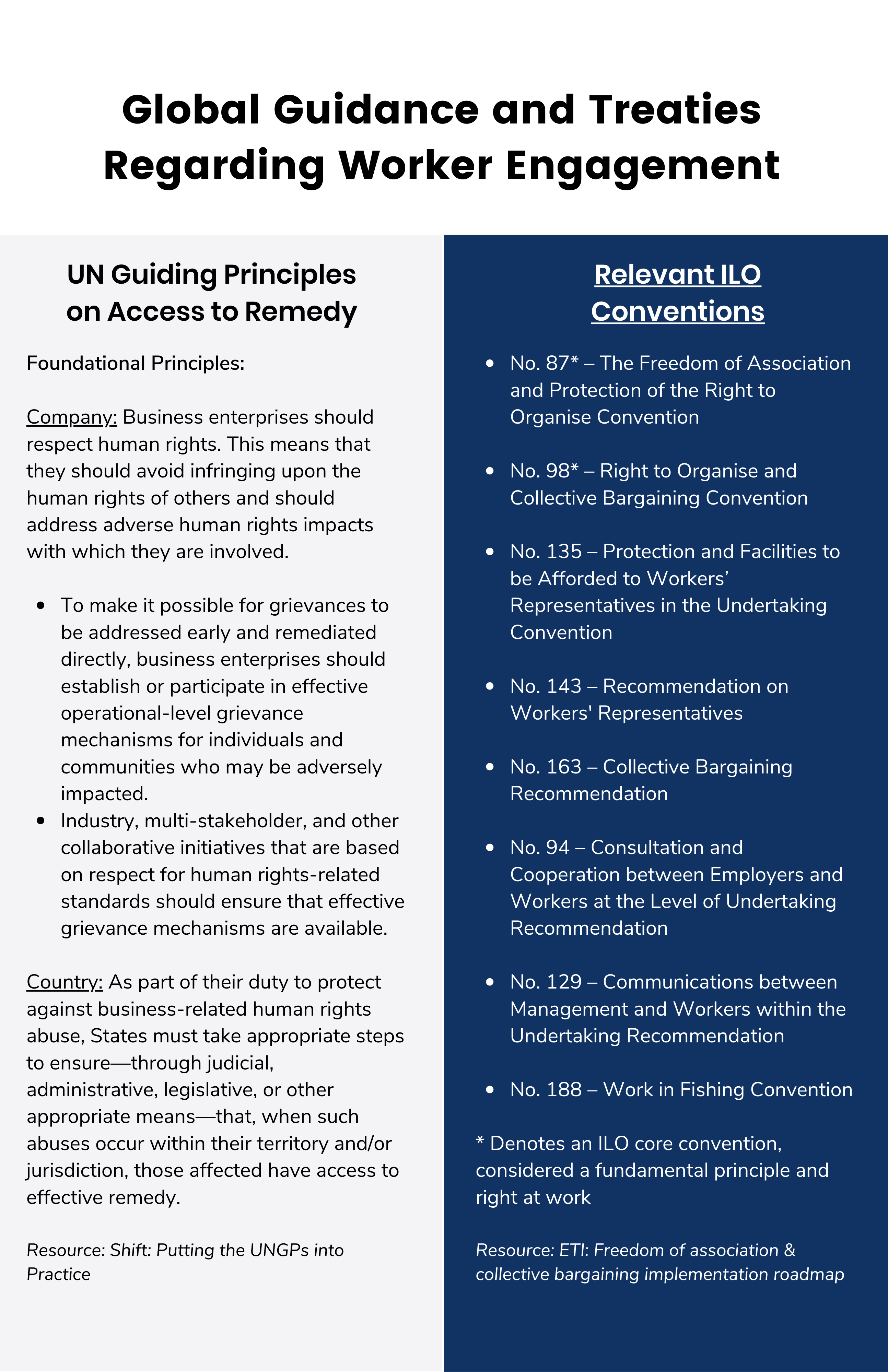
What is Worker Engagement?
Workers should have various means of engaging with their employers to make improvements to working conditions. Freedom of association and collective bargaining are fundamental worker rights that help workers to do so, and these also create the conditions for the protection of other core labor rights.
However, the right to freedom of association and collective bargaining is legally limited or underutilized in some regions and sectors such as high seas fishing. In these instances, companies can implement a range of activities—termed “worker engagement”—that enable workers to interact with employers regarding workplace culture, working conditions, and other issues. Methods of engagement may include grievance mechanisms, worker management meetings, committees, and trade unions.
- Explore more: RISE: Worker Voice Continuum.
At minimum, companies must implement effective grievance mechanisms. Workers should face no reprisal due to submitting grievances and, to be effective, companies must have transparent procedures in place to receive and examine these grievances.
- Explore more:
- ILO: Grievance handling.
- Global Compact Network Netherlands, Oxfam and Shift: Remediation and grievance mechanisms ‘Early warning, effective solutions’.
Regardless of the type(s) of worker engagement used by the company, success depends on worker uptake. Although resolving and remediating grievances can be challenging, management should welcome dialogue with workers and view it as crucial to the company’s continued growth. If no workers raise issues, reevaluate the effectiveness of the procedure and consider providing additional labor and human rights resources and training. Workers may not know how to access the grievance mechanism, or they may need more guidance in order to participate and engage meaningfully.
- Explore more:
Successful worker engagement opens up a dialogue between workers and management to improve working conditions and creates avenues for workers to identify other issues. It may even lead the company to adapt its governance approach to increase worker participation.
- Explore more:
ILO: Guidance on setting up a protocol for relations between management and workers
Why Worker Engagement Matters
The United Nations Guiding Principles on Business and Human Rights establish that companies have the responsibility to enable, establish, and uphold core labor standards, independent of whether a country’s laws fulfill its human rights obligations.. Indeed, company-led worker engagement is especially powerful in supply chains where workers have little or no access to protections or judicial remedies. Worker engagement benefits companies by strengthening operations, enhancing knowledge of supply chain issues, providing data to verify working conditions, and increasing confidence that standards and rights are upheld.
Fishing, especially in international waters, is in particular need of worker engagement mechanisms. Workers on commercial fishing vessels, especially migrant workers, are vulnerable to exploitation and abuse due to the combination of limited oversight, discriminatory laws, and lax enforcement. However, workers on vessels are hampered by their isolation. This limits their ability to communicate with personal networks or advocacy organizations for support. Additionally, unionization rates for at-sea workers are relatively low. Sectors like fisheries—in which the work occurs in remote locations with sporadic or infrequent access to communications—are more difficult to organize.
Fishing, especially in international waters, is in particular need of worker engagement mechanisms. Workers on commercial fishing vessels, especially migrant workers, are vulnerable to exploitation and abuse due to the combination of limited oversight, discriminatory laws, and lax enforcement.



By strengthening worker voice and representation, management is…investing in staff retention, boosting workplace morale, and improving productivity while preventing crises that could harm their company’s reputation and earnings.
Art Prapha, Oxfam
Ready to Take Action?
- Commit to implementing effective grievance mechanisms.
- Commit to upholding ILO core labor rights, including the ability of workers to collectively bargain and freely associate.
- If the right to free association is legally limited for all or some workers (e.g., migrants), commit to other forms of worker engagement, such as worker committees.
- Align commitments throughout the supply chain to achieve the long-term sustainability of worker engagement.
- Incorporate commitments to effective grievance and worker engagement in supplier expectations.
- Train staff and supply chain partners on core labor rights—including the right to collective bargaining and freedom of association—and the importance of access to effective grievance mechanisms.
- Share the business benefits of worker engagement, such as staff retention, increased morale, and improved productivity.
- Ensure that workers have access to information on their rights and conditions of employment from recruitment to employment.
- Empower workers with training and resources to enable meaningful participation in monitoring labor conditions and engaging in improvement processes once on the job.
Direct worker engagement provides companies with the most accurate information of conditions and worker experience. However, collecting data about and from workers requires particular safeguards to ensure protection from retaliation, recrimination, and reprisal.
- Collect data on issues raised by workers in the risk assessment, and use this information when identifying salient issues.
- Companies that collect data from workers must also be prepared to verify and remedy reported instances that violate company policy.
- If issues are not raised through grievance processes and worker engagement, utilize publicly available information from civil society or worker-support organizations to determine whether risks are actually absent or the grievance and worker engagement mechanisms are ineffective.
- At minimum, ensure effective grievance mechanisms in your company’s supply chains.
- Share information about the resolution of grievances and corrective action plans regarding grievances with workers to build trust and encourage engagement.
- Invest in establishing or scaling effective grievance mechanisms.
- Consider shared grievance mechanisms with other companies, including pooling funds to reimburse workers or provide other forms of remedy.
- Proactively remove barriers to freedom of association and collective bargaining in your company’s operations.
- Provide suitable mechanisms for ideas and concerns to be communicated from workers to management.
- To the fullest extent allowed by law, there should be no negative repercussions for organizing.
- Grant trade unions representing workers access to the workplace as appropriate.
- Advocate for all seafood workers’ right to collectively bargain and freely associate, regardless of immigration status.
- Support the legal right of workers and civil society organizations to report on and make claims of workplace abuse without fear of retribution.
- Establish dialogue and build trust with trade unions, workers networks, and local communities.
- Remediate issues raised through worker engagement, including but not limited to formal grievance mechanisms, worker hotlines, and any issues raised by trade unions, committees, or other workers’ associations by following the guidance outlined in RISE Remediate.
- Workers or their representatives should participate in verification of remedy.
- Work to achieve the following practices:
- Recognize the rights to freedom of association and collective bargaining.
- Engage in ongoing, meaningful consultation and communication with workers, worker representatives, and governments.
- Establish procedures to collect, investigate, and resolve grievances within the seafood supply chain.
- Participate in procedures to settle industrial disputes where relevant.
- For further guidance, see ILO: Q&As on business and collective bargaining.
- Report the number and type of grievances raised, including how grievances were identified, resolved, or other outcomes.
- Report the conditions outlined in any current collective bargaining agreements, the number of worker committee meetings conducted, and other ways that the company is engaging workers.
- Share the benefits of freedom of association and collective bargaining for reducing labor and human rights abuse.
- ILO:
- Open Society Foundations: Transformative Technology for Migrant Workers

